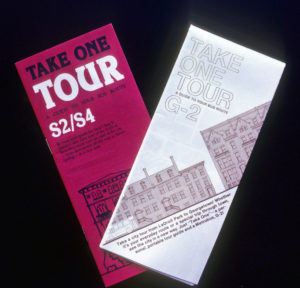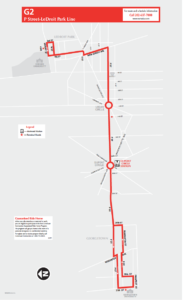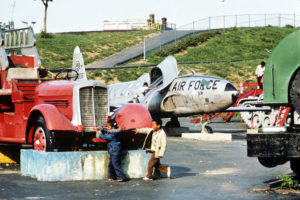Post authored by DCPL interns Rebecca Kellam and Andrew Wong
Read the full text of the Don’t Tear it Down G-2 Take One Tour.

During the mid 1970s, Don’t Tear it Down–the predecessor to today’s DC Preservation League–created the “Take One Tour,” a series of brochures distributed on buses as a guide to historically significant buildings along the routes. These brochures were intended for commuters and tourists alike and sought to raise awareness of Washington’s unique built environment. One of these routes was the G-2: a popular bus route which runs from LeDroit Park to Georgetown. Along the route, riders not only pass many beautiful examples of Federal and Victorian architecture, but also several unusual sites that the casual observer might not notice at first glance. Here is a look back at the G-2 Take One Tour and how the sites along it have both evolved and stayed the same in the near fifty years since it was first created.

The first stop on the G-2 is located at Howard University on 4th and Bryant Sts. Founded in 1866 by General Oliver O. Howard, the historically black university’s main campus features many Georgian Revival structures. The quality education provided by the university to people of all races has attracted students and academics from all over the country. In the 154 years since Howard University was first established, it has continued to have a great impact on the larger community. Many of the immediately surrounding neighborhoods were occupied by Howard professors. In the 1970s, individuals in those neighborhoods worried that the physical expansion of the university would come to harm the community it helped create.
Next on the G-2 bus route is LeDroit Park, a neighborhood founded in the 1870s, making it one of Washington’s first suburbs. Many of the original row houses were designed by architect James McGill. After the first African American family moved into the neighborhood in 1893, the previously all-white suburb became home to many locally and nationally prominent Black Americans, including educator Mary Church Terrell and poet Paul Lawrence Dunbar. LeDroit Park was made a historic district in 1974, just two years before the G-2 “Take One Tour” was distributed, and it retains much of its character today.
Just before reaching Logan Circle, the G-2 passes through the Shaw neighborhood. This area takes its name from Shaw Junior High School, which in turn is named for Robert Gould Shaw: a Union officer who led one of the first African American units during the American Civil War. As the brochure notes, this large, densely populated residential area was first developed between 1880 and 1910, and still contains some of Washington’s best examples of row house architecture. The neighborhood has not significantly changed since the bus tours began in the 1970s, and in 1999 much of the area was included in the then newly-formed Shaw Historic District.

Located within the Shaw neighborhood is one of the more unconventional sites listed on the G-2 Take One Tour brochure: the John F. Kennedy Playground. Dedicated in 1964 by Attorney General Robert F. Kennedy, the park is located on P St between 7th and Marion Sts NW. When it was first established, the unusual playground’s equipment was made up of old tanks and jets, a steam locomotive, and a huge slide. Although the playground was extremely popular for some time, it fell into disrepair by the late 1970s and became unsafe for children. Most of the tanks and planes were turned into scrap metal, but the locomotive was restored and put on display in the National Museum of American History. Today, the JFK Recreation Center and a more conventional playground occupy the lot, continuing the site’s legacy as a place for children to play.
As the G-2 continues its route, it intersects with Logan Circle. In the 1970s and today, Logan Circle is the only original traffic circle in Washington to retain a residential character. The houses on the circle– ornamented with carvings, chimneys, turrets, and ironwork–serve as strong examples of Victorian architecture. Designated a historic district in 1972, many of the mansions and row houses were undergoing restoration when the brochures were being distributed. Although most of the houses and mansions have been converted into apartments or boarding houses, the exteriors of most buildings remain relatively unchanged.

On the opposite end of the G2’s route from LeDroit Park is Georgetown, the popular, upscale neighborhood along the Potomac River waterfront. Georgetown is undoubtedly one of DC’s most well-known historic districts, and the G2’s path through Georgetown along P and O Streets is densely packed with historically significant sites. These sites range from the prominent Georgetown University to the oldest Black church in the District (Mt. Zion Methodist), and also include many smaller ones such as old streetcar tracks and a gun barrel fence. Of particular note are the many different styles of houses which coexist on Georgetown streets. As Georgetown began to decline economically during the late 19th century, it continued to grow, but within itself, by subdividing. The result: mansion and modest; brick and frame; Georgian and Modern may all be found in one city block. In combination, these places make Georgetown an urban setting unlike any other in the nation’s capital–and like few others in the world.

Throughout the brochure, the “Take One Tour” for the G-2 bus line emphasizes the importance of the physical environment in Washington. It encourages the public to learn more about the structures along public transportation routes by not only talking about specific sites, but also by discussing stylistic traits shared by several buildings and neighborhoods, such as fanciful red brick detailing, turrets, and mansard roofs. These characteristics are a part of what makes Washington special. Don’t Tear It Down used the G-2 and other “Take One Tour” brochures to emphasize the importance of protecting the physical environment and advocating for preservation as a way to strengthen a community. As its fiftieth anniversary approaches, the DC Preservation League continues its mission to make learning about DC’s history and preservation easy and accessible to all through several online resources–such as the DC Historic Sites App–and actively works towards the protection of the physical environment.
